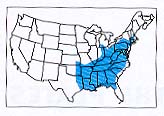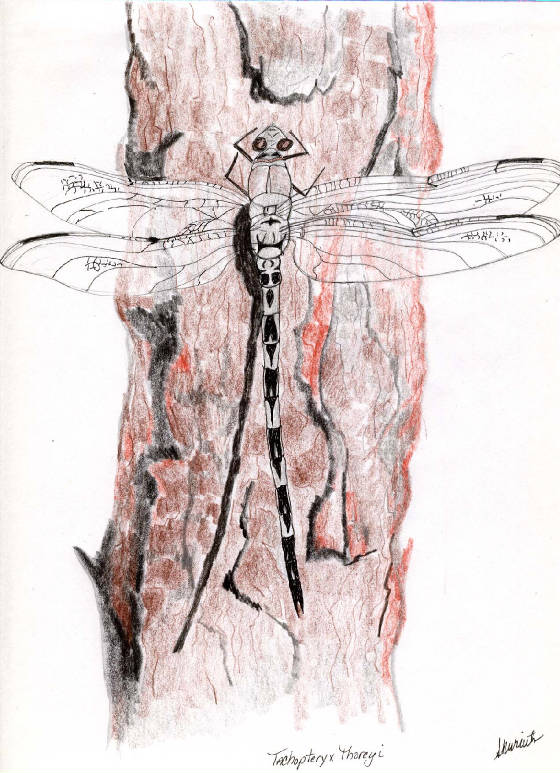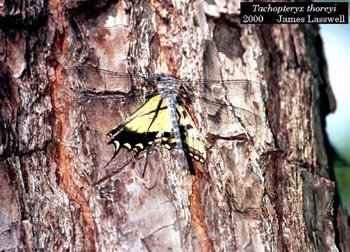|
GEOGRAPHIC
RANGE AND HABITAT
Tachopteryx thoreyi lives in the Eastern United States, from as far North as New
York State, to as far South as Northern Florida. They range as far West as Eastern
Texas and Oklahoma. See map below. The grey petaltail inhabits deciduous forests. They require clean spring fed seeps in these forests.
| (Dunkle, 2000, p.250) |

|
BEHAVIOR For those who live where winters become cold, larvae
must winter under leaves, in the mud of seepages or shallow water, until spring. Adults do not migrate, nor do they survive
the cold weather. (Novak, 2002) and (Dunkle, 2002). According to Ethan Bright and Mark F. O'Brien, at the University of Michigan, larvae may grow for 3 years prior to emerging as and adult. Adults
like to perch on sunny areas of tree trunks, where they are quite camouflaged. (Dunkle, 1981, p.194), (Bright & O'Brien,
1999) Sometimes when the temperatures drop, they “wing-whir” to increase their temperature. They can hover, or
fly at about 100 body lengths per second, as well as backwards at about three body lengths per second. (Waggoner &
Sabet-Peyman , 2000, introduction to the odonata)

|
|
Reproduction
Male t.thoreyi k seek females 23 days after emergence. (Dunkle, 1981, p. 195) Males search for females by flying
up the sunny side of tree trunks, and then fly smoothly to search the next tree trunk. At other times, males wait for females
near the seeps, usually from around 10 am to 4 pm. They wait in sunny places on thick weeds and vines. (Dunkle, p.194)
It was noted by Dunkle, t. thoreyi also hunted prey while seeking a mate, which was not characteristic of other anisoptera.
Mating occurs high in the forest canopy while in flight. The male grasps the female by the head, and they fly in tandem. The
female curves and they form a “wheel position”. (Trueman & Rowe, 2001) In some species, the male removes
any other males’ sperm with a scoop-like appendage prior to depositing his own. In some species, the pair remain in
tandem while the female lays her eggs, in others, the male hovers nearby to guard her from other males, while some species
fly away and the female lays eggs alone. (Trueman & Rowe) It is not discussed which behavior t. thoreyi exhibit.
T. thoreyi females lay eggs among roots in thick grasses and fallen leaves, or mud. Their ovipositors contain blades
to assist with this. T. thoreyi females lay long oval shaped eggs, which start out yellow, then turn orange-brown.
(Dunkle, p.190) The incubation period is 32 days (for eggs hatched in captivity at room temperature). (Dunkle, p.190) The
larvae come out of the egg through a curved slit. They are pale brown at first, and eventually turn dark brown, with a white
stripe on the abdomen. While in the larval stage, they molt many times the larvae eat other insects, such as small cockroaches.
They prefer mud to water, and do not swim. Dunkle supposes this helps prevent them from being washed away when it rains. There
is no pupal stage, so they are called hemimetabolous, meaning partial metamorphosis. When the adult is ready to emerge, they
cling to upright stems, and the wings open from the base to the tip. The wings have a pinkish tint when newly emerged. Dunkle
states he did not find t. thoreyi to be shy, as another naturalist had thought, and in fact, these dragonflies even landed
on people at times. |

DIET T. thoreyi are carnivorous. They can capture larger
sized prey than most anisoptera. (Dunkle, 1981, p.195) Some examples of what they were eating are: butterflies, including
Swallowtails, moths, other odonates, and beetles. They will pretty much eat whatever kind of insect is available.
Some have even been know to eat tadpoles and tiny fish. They are valuable for keeping numbers of mosquitoes down.
|

